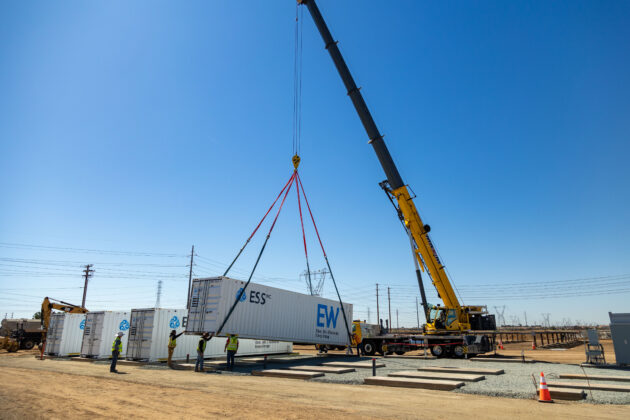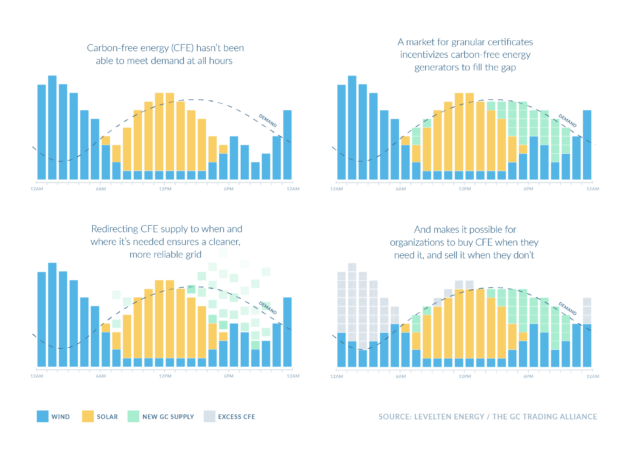
A growing number of organizations as well as the U.S. government are moving beyond commitments to purchase 100% clean energy to power their operations. They’re aiming for carbon-free power 24-hours-a-day, seven-days-a-week.
Seattle startup LevelTen Energy, Microsoft, Google, and two clean energy companies announced on Thursday that they’re partnering to create a marketplace to help groups with climate pledges accomplish that ambitious goal.
Most corporate-backed clean energy efforts so far have focused on ramping up installations of solar and wind power facilities. But those power sources aren’t always available. To supply carbon-free power around-the-clock means adding energy sources such as nuclear, hydrogen fuel, batteries and geothermal to the mix.
The first-of-its-kind marketplace will allow energy buyers to purchase from energy producers what are called “granular certificates” — essentially documents verifying when and where the power is generated. It will allow producers of these less common energy sources to market their alternative solutions to carbon-free power.
“This is creating new price signals to incent new types of clean energy to come on the grid to fill some of those gaps so that we can deliver clean energy when the wind’s not blowing and the sun’s not shining,” said Jason Tundermann, LevelTen’s chief operating officer, in a GeekWire interview.
“This is creating new price signals to incent new types of clean energy to come on the grid…”
– Jason Tundermann, LevelTen Energy COO
The collaboration — dubbed the Granular Certificate Trading Alliance — is building an “ecosystem,” Tundermann said, to connect energy buyers and sellers and manage the exchange of the granular certificates.
The project is being developed in partnership with the Intercontinental Exchange (ICE), which operates global financial exchanges. The alliance is led by LevelTen and its founding members are Microsoft, Google, AES and Constellation.
In addition to helping build the project, the founding members strategize to be among the first users of the marketplace, as both Microsoft and Google have set goals for using clean power 24/7 by 2030. The trading platform is expected to launch next year.
“This marketplace opens new opportunities for buyers and sellers to access granular carbon-free energy and creates an hourly price signal — important for driving investment in assets that deliver carbon-free energy in the right place, at the right time,” said Adrian Anderson, Microsoft’s general manager of renewables and carbon free energy, in a statement.
LevelTen, which launched in 2016, also operates the world’s largest marketplace for power purchase agreements, which maintain the deployment of clean power installations by matching energy developers with guaranteed, often long-term customers for the electricity.
Initially, it was just a few big companies signing the agreements to buy clean power, “then it’s absolutely exploded,” Tundermann said. Now businesses large and small are paying for the deals in order to accomplish their climate targets.
LevelTen hopes the same thing can happen with granular certificates.

Here’s an example of how it could work:
- A company is building a new facility that it estimates will use 100 megawatt hours of electricity per year, so it makes a power purchase agreement with a solar developer to supply a large slice of that energy.
- But the company’s operations run through the night, so it uses the new platform to make a bid to buy granular certificates from a battery startup that’s plugging into the grid.
- If the company buys more of the granular certificates than it ultimately needs, they can be traded.
The platform can also assist companies that instead of striving for clean power 24/7 are aiming to maintain carbon-free energy in areas using the most polluting power sources. The goal here is to create opportunities to retire and exchange the dirty power plants. Amazon is among the companies following this strategy.
Tundermann said they expect first to attract the companies and organizations eager to buy the power, then the suppliers will follow.
“You have to start with the ‘pull,’” Tundermann said. “The trading platform will allow us to collect and aggregate all these demand signals and really show that to the [energy] developer market. At that point, it’s up to them to come up with the supply.”

